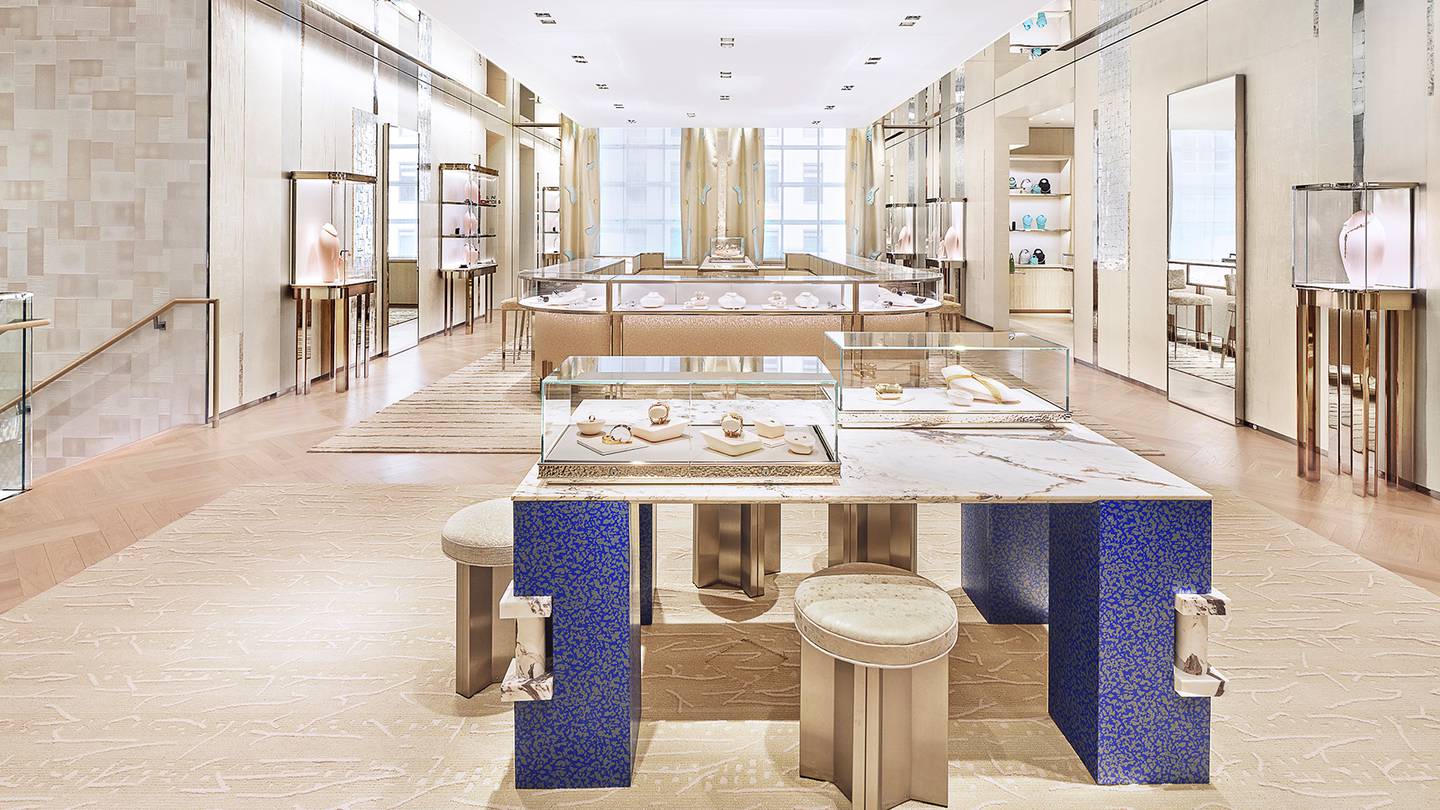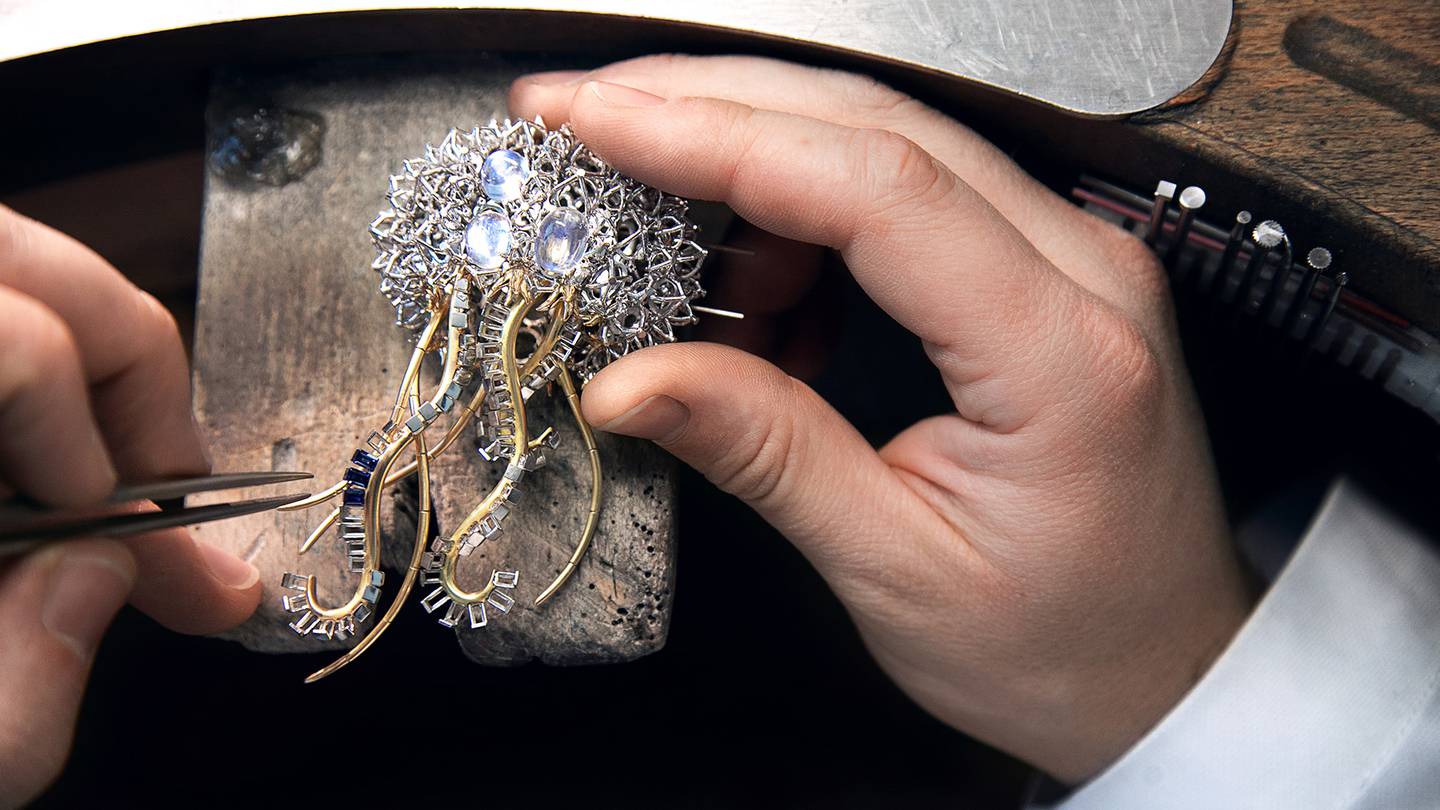
In the two-plus years since acquiring Tiffany in a $16 billion blockbuster deal, LVMH has gradually revealed its plans to remake the brand from the bottom up. There was the Beyoncé and Jay-Z campaign, the “Lock” fine jewellery collection and the recently reopened flagship designed to please window-shopping tourists and high rollers alike.
Now, change has come to the top: The brand on Monday revealed its 2023 “Blue Book” collection of high jewellery, a series of intricate pieces priced upwards of $75,000 that marks the brand’s first high jewellery collection since bringing on former Cartier designer Nathalie Verdeille as chief artistic officer in 2021, as well as the first collection fully developed under LVMH.
Inspired by the archives of marine life-obsessed former designer Jean Schlumberger — who led Tiffany’s studio during its mid-20th century heyday — the collection includes spiky diamond and ruby creations inspired by sapphire-encrusted coral, sapphire-and-moonstone jellyfish rings and a diamond-encrusted shell hiding a 21-carat black opal.
High jewellery has evolved into a profitable and fast-growing niche in addition to a key exercise for top luxury brands’ prestige. That’s partly down to its rarity: just a handful of luxury brands source exceptional gemstones for their limited-edition lines, where prices typically start in the high five figures and regularly run into the tens of millions.
Stones like the suite of 35 pink diamonds Tiffany recently acquired from the now-closed Argyle Mine are proving irresistible to the ultra-high-net-worth customers that have become so important to global luxury brands’ success. Dior and Chanel are also working to expand their high jewellery businesses, staging major events in Como and London this week, respectively.
“A focus on high jewellery is non-negotiable; it’s been very much part of the success of Tiffany,” chief executive officer Anthony Ledru told BoF.
“There has been so much creation of wealth the past 5 to 10 years, and the average age of high jewellery clients dropped a lot, especially in Southeast Asia, China, or Malaysia,” he added. “Then, when you have something unique that the client wants, what’s the price tag?”
As Tiffany leans into high jewellery, it’s hoping to grow the category as well as pushing it even higher: The brand decided to phase out all “enhanced” stones, pushing teams to source only an extra-rare grade of sapphires and rubies that have not been heated to intensify colours or dissipate inclusions, or emeralds that haven’t been oiled to fill in pores.
The company entered an agreement to buy two major French workshops for high jewellery, Orest and Abysse, earlier this year, more evidence it sees the segment as a true growth opportunity rather than simply an image play. In addition to one-off pieces in its seasonal “Blue Book” collection (for which the cover of its historic catalogue inspired the brand’s signature blue boxes), Tiffany is ramping up sales of its “Bird on a Rock” line, an icon of the Schlumberger era in which jewel-incrusted cockatoos are perched on large gemstones.
High jewellery has also become a priority as Tiffany tries to shake a reputation for depending on entry-priced silver trinkets to drive its business — as lines like heart-shaped “Return to Tiffany” charms sometimes drowned out the brand’s legacy for prestigious diamond work. A 2021 campaign featuring Beyoncé wearing the famed “Tiffany diamond” was a first gambit by Alexandre Arnault, the brand’s executive president for product and communications, followed more recently by efforts like a push to dress men on the red carpet with Schlumberger’s bird brooches.
Upmarket Push
Tiffany has grown its high jewellery business by 300 percent since the LVMH acquisition, achieving “hundreds of millions in additional sales”, Ledru said. Silver lines, meanwhile, are now estimated to make up 14 percent of sales, compared to around one-fourth of revenues prior to the acquisition.
“For a brand like Tiffany high jewellery is an opportunity to accelerate the shift in perception,” HSBC analyst Erwan Rambourg explained. “Many people think Tiffany is a gifting brand run by silver, and it’s not.”
High jewellery is just one part of the puzzle. The brand plans to animate classic collections more aggressively in the much-bigger fine jewellery segment, with items earmarked for marketing support and refreshed designs including Schlumberger’s “Jackie” bracelet or Elsa Peretti’s sensual cuffs. Schlumberger’s bird motif also represents a prime opportunity to develop more accessibly priced declinations in seasons to come, Ledru said.
“The job of Nathalie [Verdeille] is to be a prophet of the past … A designer of Tiffany needs to ask, what would Schlumberger do today?” Ledru said. As a brand founded in 1837, the weight of Tiffany’s heritage “means constraints, it means responsibility but it also means authenticity. There’s no ex nihilo creation at Tiffany, only transformation.”
Previously Cartier’s fine jewellery creative director for 16 years, Verdeille has proved herself as an expert curator of archives, with a knack for “finding something to twist a creation and make it contemporary without changing the essential,” Ledru said.
Polishing the Silver
Tiffany’s approach to silver jewellery is also being revised: the brand is pushing chunkier, more complex (and more expensive) silver designs like its Hardware range to gradually shrink the share of entry-priced silver charms like its “Return to Tiffany” line, as well as upgrading the heart-shaped “Return” line with gemstones and gold-plated details. For the brand’s most recent major fine jewellery release, Lock, it opted not to offer silver at all.
“We’re not ashamed of silver, it’s part of our heritage,” Ledru said. “What we’re not O.K. with is when silver becomes too commodified, or silver that takes the brand down where it’s not supposed to be.” The entry price at Tiffany has roughly doubled to over $500 as part of LVMH’s upscaling push.
In addition to higher-end products, the company is also working to upgrade its retail network in order to grow its market share among top-end buyers, particularly abroad. “The last piece of the puzzle is the retail network, this is where we have the greatest opportunity,” Ledru said.
While Tiffany has long been the biggest jewellery brand in the US, it continues to lag the likes of Cartier and Bulgari in Europe, the Middle East and Asia — which is becoming a higher-stakes market for the luxury industry as investors count on a rebound in China to make up for slowing growth in the US.

Following the reopening of its “Landmark” flagship in New York in April, the brand is working to develop a network of around 15 big (though less big) flagships it will position as “cultural hubs,” mixing products with art, archival jewellery, food and hospitality.
A recent opening in Dubai Mall is set be followed up by renovations and openings including a new location in Tokyo’s trendy Omotesando district.
Ledru declined to comment on reports of a pending LVMH reshuffle on the Champs-Elysées thoroughfare, where the group’s acquisition of the former HSBC headquarters could set off a round of musical chairs among its top brands. He confirmed, however, that in the medium-term Tiffany hoped to upgrade its Paris presence with “very strong flagships” on both the Champs-Elysées and Place Vendôme.
Analysts expect Tiffany to keep growing at a clip as the brand follows up splashy marketing with upgraded products and stores. The brand is on track to increase sales an average of 20 percent per year after crossing the threshold of $5 billion in 2022, according to HSBC.
“Jewellery is in a bit of a super-cycle of growth,” Rambourg said. In the mostly unbranded, less competitive sector compared to fashion, the blockbuster acquisition of Tiffany served as a “bit of a wake-up call for the entire industry” causing rival brands to update their marketing and retail efforts alongside LVMH.
Joan Kennedy contributed reporting to this article.
LVMH is part of a group of investors who, together, hold a minority interest in The Business of Fashion. All investors have signed shareholders’ documentation guaranteeing BoF’s complete editorial independence.
Disclosure: LVMH is part of a group of investors who, together, hold a minority interest in The Business of Fashion. All investors have signed shareholders’ documentation guaranteeing BoF’s complete editorial independence.


